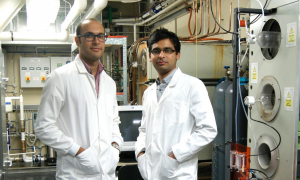A team of Australian researchers from the Royal Melbourne Institute of Technology (RMIT) have discovered a new way to improve electronics using what they call “nano-earthquakes”.

Image credit: www.rmit.edu.au
The work is a collaborative effort between MNRL, led by Professor Leslie Yeo, and the FMM Research Group, led by Dr Madhu Bhaskaran and Dr Sharath Sriram.
Working with surface acoustic waves and using them to modify the electronic properties of a material, the scientists found that sound waves, when properly controlled, can affect the electronic properties of 2D materials like graphene.
“Sound waves can be likened to ripples created on the surface of water, but where we can control the direction and intensity of these ripples,” said Walia, a Research Fellow in the School of Electrical and Computer Engineering, in a news release.
“In this work, we use these ripples which occur on a crystal surface and couple it into a material that is a few atomic layers thick (2D material), which causes a change in its electronic properties. As the surface acoustic waves are turned on and off or increased and decreased in intensity, the change in electronic properties of the 2D materials follows the same pattern.”
The study, published in the journal Advanced Optical Materials, could present new advancements for improved solar cell efficiency as well as imaging sensors in mobile phone cameras and fluorescence imaging.
“A simple technique to control these properties without affecting their inherent chemical and physical characteristics has been a primary scientific hurdle that has hindered their transformation into commercial products,” added Rezk, who is a member of RMIT’s Micro/Nano Physics Research Laboratory (MNRL) and a Research Fellow in the School of Civil, Environmental and Chemical Engineering.
“We’ve found that ‘nano-earthquake’-like waves under the surface of the 2D materials drag electrons along their path, thereby tuning the amount of light emitted by the material. Remarkably, the acoustic wave based tunability did not result in any structural or compositional change in the material. As soon as the acoustic waves were removed, the material retracted back to its initial optical state, and therefore this mechanism is highly adaptable for a variety of dynamically operating systems.”
The research was supported by the Australian Research Council and undertaken at RMIT’s state-of-the-art MicroNano Research Facility.




















